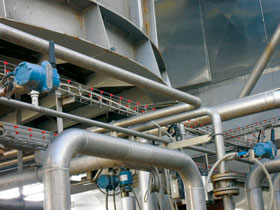

When instruments are required to be installed in hazardous areas, there is a requirement that all wiring must be installed and maintained to the relevant standards to prevent an ignition of the explosive environment. The costs of protecting a wired 4-20 mA HART instrument in hazardous areas is not just simply the installation cost but also ongoing inspections and remedial works that will inevitably follow.
WirelessHART devices certified to the relevant protection level for the hazardous area can reduce the duration and complexity of inspections due to the reductions of equipment installed in the hazardous area, such as the wiring, junction boxes, cables and IS barriers needed with a traditional wired installation. WirelessHART process transmitters can be powered by an IS power module, which eliminates the need for power and signal wiring. Such power modules are field interchangeable in the hazardous location.
Inspection requirements
4-20 mA HART field transmitters require wiring, conduits, cable trays, field junction boxes and marshalling cabinets. If the instrument is 4-wire, it must have separate power wiring. All wiring systems must meet the requirements of IEC 60079 for the type of protection that the circuit is certified for. This could be ‘EX ia’ for intrinsically safe, ‘Ex d’ for explosion-proof or one of the other types of protection permitted.
IEC 60079 covers the use of electrical equipment in hazardous areas. IEC 60079-14 requires that an initial inspection must be carried out when the equipment is first installed. IEC 60079-17 says that the interval between following inspections shall not exceed three years without seeking expert advice. Typical inspections are done annually.
Cutting costs with WirelessHART
Adoption of WirelessHART equipment can have significant impact on both capex (capital expenditures) and opex (operating expenses).
In the capex phase, designs using a wireless device can achieve cost savings. By removing the glands, wires, conduit/tray, field junction boxes and marshalling cabinets wiring component costs are reduced, and further savings are realised by eliminating associated installation drawings and equipment lists that are required for maintenance and installation.
WirelessHART also reduces opex, especially the cost of hazardous area inspections. This is due to not having to have supporting infrastructure between the device and the host system for the measurement circuit. Only the instruments themselves have to be inspected and possibly the wireless gateways if they are installed in the hazardous area. In many instances, these gateways can be installed outside of the hazardous area, further cutting costs.
In comparison the costs of inspecting and maintaining wired 4-20 mA HART or fieldbus process instruments in a hazardous area is very high because of the need to support the instruments with an infrastructure including power supplies, wires, and conduit and marshalling cabinets. All of these items need to be protected from igniting a flammable or explosive atmosphere, all of this equipment needs to be inspected on a regular basis, and repairs are often required to keep the entire system safe.
Using WirelessHART eliminates wiring infrastructure, and reduces required inspection tasks.
For more information contact Michael Eksteen, Emerson Process Management, +27 (0)11 451 3700, [email protected], www.emersonprocess.com
| Tel: | +27 11 451 3700 |
| Fax: | +27 451 3800 |
| Email: | [email protected] |
| www: | www.emerson.com |
| Articles: | More information and articles about Emerson Automation Solutions |

© Technews Publishing (Pty) Ltd | All Rights Reserved